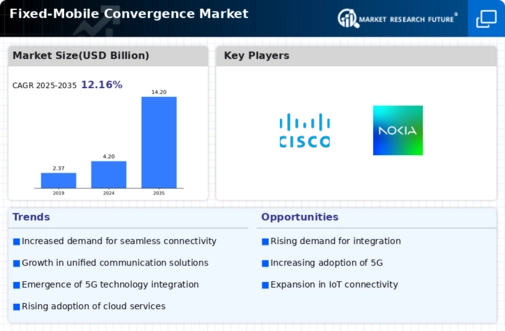Market Growth Projections
The Global Fixed-Mobile Convergence Market Industry is poised for substantial growth, with projections indicating a rise from 4.2 USD Billion in 2024 to 14.2 USD Billion by 2035. This growth trajectory suggests a robust compound annual growth rate (CAGR) of 11.68% for the period from 2025 to 2035. Such figures reflect the increasing adoption of integrated communication solutions across various sectors, driven by technological advancements and changing consumer preferences. The market's expansion is likely to be fueled by the convergence of fixed and mobile networks, enabling service providers to deliver enhanced services that meet the evolving demands of consumers.
Emergence of IoT and Smart Devices
The emergence of the Internet of Things (IoT) and smart devices is reshaping the Global Fixed-Mobile Convergence Market Industry. As more devices become interconnected, the demand for seamless communication between fixed and mobile networks intensifies. IoT applications, ranging from smart homes to industrial automation, require robust connectivity solutions that can support high data volumes and low latency. This trend is driving service providers to innovate and offer integrated solutions that cater to the needs of IoT users. The growth of IoT is expected to significantly contribute to the expansion of the Global Fixed-Mobile Convergence Market Industry, creating new opportunities for service providers.
Advancements in Network Infrastructure
The Global Fixed-Mobile Convergence Market Industry is significantly influenced by advancements in network infrastructure. The deployment of 5G technology and improvements in broadband connectivity are facilitating faster and more reliable communication services. These advancements enable service providers to offer innovative solutions that combine fixed and mobile services, enhancing user experiences. As a result, the market is expected to grow substantially, with projections indicating a rise to 14.2 USD Billion by 2035. Enhanced network capabilities not only support higher data speeds but also foster the development of new applications, thereby driving the demand for fixed-mobile convergence solutions.
Consumer Preference for Bundled Services
The Global Fixed-Mobile Convergence Market Industry is witnessing a shift in consumer preferences towards bundled services. Customers increasingly favor packages that combine mobile, internet, and television services, seeking convenience and cost savings. This trend is particularly pronounced in urban areas, where consumers are more likely to adopt comprehensive service bundles. Service providers are responding by creating attractive offers that cater to this demand, which could lead to increased customer retention and satisfaction. As the market evolves, the emphasis on bundled services is likely to play a crucial role in shaping competitive strategies within the Global Fixed-Mobile Convergence Market Industry.
Regulatory Support for Convergence Initiatives
Regulatory support for convergence initiatives is a key driver of the Global Fixed-Mobile Convergence Market Industry. Governments worldwide are increasingly recognizing the benefits of integrated communication services and are implementing policies to encourage convergence. This includes facilitating spectrum allocation and promoting competition among service providers. Such regulatory frameworks not only enhance market dynamics but also stimulate innovation within the industry. As a result, the market is poised for growth, with a projected CAGR of 11.68% for the period from 2025 to 2035. This supportive regulatory environment is likely to foster the development of new technologies and services that further enhance fixed-mobile convergence.
Increasing Demand for Unified Communication Services
The Global Fixed-Mobile Convergence Market Industry experiences a rising demand for unified communication services, driven by the need for seamless connectivity across devices. Businesses are increasingly adopting solutions that integrate voice, video, and messaging into a single platform. This trend is evident as organizations seek to enhance collaboration and productivity. The market is projected to reach 4.2 USD Billion in 2024, reflecting a growing recognition of the value of integrated communication solutions. As companies continue to prioritize efficiency, the adoption of unified communication services is likely to accelerate, further propelling the growth of the Global Fixed-Mobile Convergence Market Industry.












